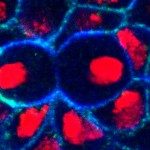Link to Pubmed [PMID] – 26344089
Curr. Biol. 2015 Sep;25(18):2339-48
Gamete compatibility is fundamental to sexual reproduction. Wolbachia are maternally inherited endosymbiotic bacteria that manipulate gamete compatibility in many arthropod species. In Drosophila, the fertilization of uninfected eggs by sperm from Wolbachia-infected males often results in early developmental arrest. This gamete incompatibility is called cytoplasmic incompatibility (CI). CI is highest in young males, suggesting that Wolbachia affect sperm properties during male development. Here, we show that Wolbachia modulate testis development. Unexpectedly, this effect was associated with Wolbachia infection in females, not males. This raised the possibility that females influenced testis development by communicating with males prior to adulthood. Using a combinatorial rearing protocol, we provide evidence for such a female-to-male communication during metamorphosis. This communication involves the perception of female pheromones by male olfactory receptors. We found that this communication determines the compatibility range of sperm. Wolbachia interfere with this female-to-male communication through changes in female pheromone production. Strikingly, restoring this communication partially suppressed CI in Wolbachia-infected males. We further identified a reciprocal male-to-female communication at metamorphosis that restricts the compatibility range of female gametes. Wolbachia also perturb this communication by feminizing male pheromone production. Thus, Wolbachia broaden the compatibility range of eggs, promoting thereby the reproductive success of Wolbachia-infected females. We conclude that pheromone communication between pupae regulates gamete compatibility and is sensitive to Wolbachia in Drosophila.

